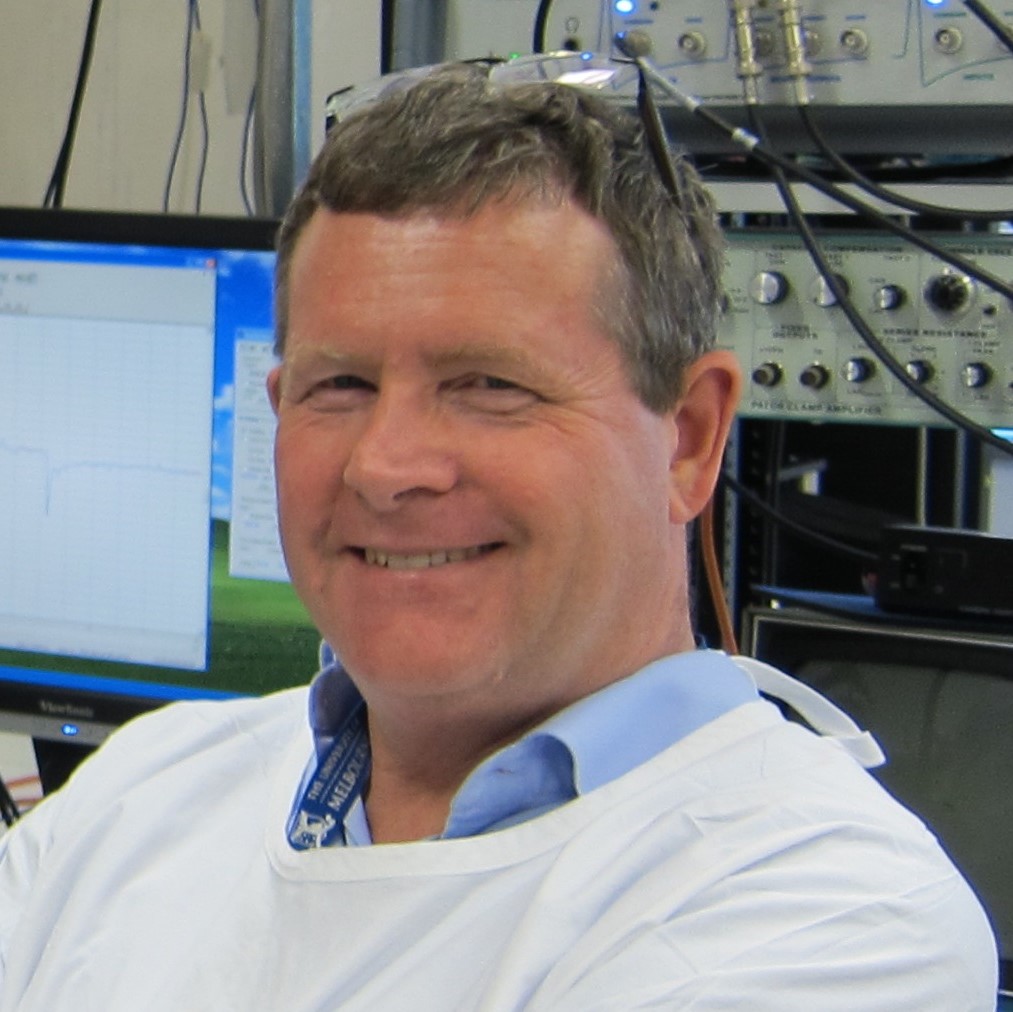Neural Dynamics Laboratory
-
Group Leader

Dr Chris French
Research Overview
Our group studies neural systems in action “neural dynamics”– from pathological states of hyperexcitability to how memories are encoded. As a clinically based group, we are also keenly interested in how drugs modulate the brain’s activity, for example, how antiepileptic and antipsychotic drugs work. We also seek to understand how drugs “go bad” to disrupt normal function, like inducing seizures.
Our techniques range from fine grained molecular dynamical modelling of atomic interactions of drugs with ion channels with supercomputers through to studying brain wave patterns in alert animals. Our main technique is electrophysiology, especially “patch-clamping”. With these methods, we can record in real-time from single cells either isolated or in a functioning neural network, in vivo or in vitro, and similarly test drug responses. Additionally, we try to interface our electrophysiological data with computer models using the “Neuron” simulator or Matlab. We are currently enhancing our electrophysiological techniques with “neuro-optical” methods such as the “miniscope” that allows visualisation of hundreds of active cells in freely moving animals over months, and have recently commenced recording from human brain cells derived from human neurosurgical operations.
Recently we have started studying how brain tumours affect brain function, especially the induction of often debilitating seizures. We have developed an in vitro brain tumour model that allows us to observe the invasion of normal brain tissue by tumour cells, as well as the development of epileptic activity.
Staff
- Dr Chris French, Group Leader,
- Dr Christina Phassouliotis, Research Coordinator
- Dr Patrick O’Brien, Post-Doctoral Researcher
- Ms Forough Habibollahi, PhD student
- Dechuan Sun, PhD student
- Harvey Chong, Research Assistant, MD Research Project Student
- Han Kim, MD Research Project Student
- Kaan Karabatak, Masters Student
- Karl Cui, Medical Student
Collaborators
National
Molecular Dynamics:
- Professor Toby Allen, Royal Melbourne Institute of Technology
Human Brain Electrophysiology
- Associate Professor Lucy Palmer, Florey Institute of Neuroscience and Mental Health
- Professor Greg Stuart, Australian National University
- Dr Gui Silva, Australian National University
- Associate Professor Andrew Morokoff, Royal Melbourne Hospital Neurosurgery
- Professor Kate Drummond, Royal Melbourne Hospital Neurosurgery
In vitro Brain Tumour Model
- Dr Rodney Luwor, Royal Melbourne Hospital Surgery
Neuro-optical Brain Recording
- Associate Professor Ranjith Unnithan, University of Melbourne (Electrical and Electronic Engineering)
In vivo Epilepsy Recording and Neuro-optical Imaging
- Professor Trichur Vidyasagar, University of Melbourne (Visual Neuroscience)
- Dr Celine Boiteux, Royal Melbourne Institute of Technology
- Professor David Williams, University of Melbourne
- Professor Terry O’Brien, Monash University
- Professor Ian Forster, Florey Institute of Neuroscience and Mental Health
- Dr Geza Berecki, Florey Institute of Neuroscience and Mental Health
- Professor David Adams, University of Wollongong
- Dr Rocio Finol-Urdaneta, University of Wollongong
International
Neuro-optical Recording, Voltage-Gated Ion Channel Studies
- Professor Francisco Bezanilla, University of Chicago
- Dr Joao De Souza, University of Arizona, Tucson
- Associate Professor Jon Silva, Washington University
- Dr Maciej Dawidowski, Medical University of Warsaw
- Assistant Professor Keith Hengen, Washington University, Saint Louis
- Dr Richardson N Leao, Neurodynamics Lab, Head, Brain Institute, UFRN/Brazil
Funding
- Australian Brain Foundation
- RMH Neuroscience
- RMH Grant in Aid
- RACP
- UCB
Research Outcomes
- Dechuan Sun, Mojtaba Kermani, Matt Hudson, Xin He, Ranjith Rajasekharan Unnithan, Chris French (2020). Effects of Antipsychotic Drugs and Potassium Channel Modulators on Cognition-related Local Field Potential Spectral Properties in Mouse Hippocampus and Frontal Cortex. doi: https://doi.org/10.1101/2020.05.26.116343.
- Dechuan Sun, Ranjith Rajasekharan Unnithan, Chris French (2020). Observations of the Effect of Scopolamine on Hippocampal CA1 Place Cell and Network Properties in Freely Moving Mice Using Miniscope Imaging. doi: https://doi.org/10.1101/2020.05.27.120352.
- Taing, K. D., O’Brien, T. J., Williams, D. A., & French, C. R. (2017). Anti-Epileptic Drug Combination Efficacy in an In Vitro Seizure Model – Phenytoin and Valproate, Lamotrigine and Valproate. PLOS One, 12(1), 2017
- Zeng, Z., Hill-Yardin, E. L., Williams, D. A., O’Brien, T. J., Serelis, A., & French, C. R. (2016). The Effect of Phenytoin on Sodium Conductances in Rat Hippocampal CA1 Pyramidal Neurons. J Neurophysiol. 2016 116(4):1924-1936
- French C, Zeng Z, Williams DDA, , Hill-Yardin EL,, O'Brien TJ J. Properties of an Intermediate-duration Inactivation Process of the Voltage-gated Sodium Conductance in Rat Hippocampal CA1 Neurons. J Neurophysiol 115:790-802
- Boiteux, C., Vorobyov, I., French, R. J., French, C., Yarov-yarovoy, V., Allen, T(2014). Local anesthetic and antiepileptic drug access and binding to a bacterial voltage-gated sodium channel. PNAS, 111(36), 13057–3062
Research Projects
- Student Opportunities
- How do Anti-Epileptic Drugs Work?
- Effects of Drugs on Cognition-Related Brain Wave Signals in the Rat
- Modelling Epilepsy and Epilepsy Drug Effects–Computational Neuroscience Project
- Electrophysiological Properties of Human Brain Neuronal Tissue
- In vitro brain tumour model – studying epileptic seizure development and sensitivity to anti-cancer therapy
- Sodium Channels in Epilepsy
- Brainwave and Electrophysiological Biomarkers of Cognition Enhancing Drugs
- Can We Fix Dementia with Deep Brain Stimulation?
- Massively Parallel Optical Imaging of Cognition Events in Neuronal Networks in Freely Behaving Mice
Faculty Research Themes
School Research Themes
Neuroscience & Psychiatry, Cancer in Medicine
Key Contact
For further information about this research, please contact Group Leader Dr Chris French
Department / Centre
Unit / Centre
MDHS Research library
Explore by researcher, school, project or topic.